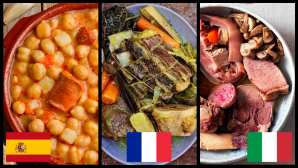The national dish of Portugal (it’s not codfish…)

Ask folks around Lisbon what they think is the most iconic dish of our city, and chances are they will say sardinhas assadas. After all, charcoal grilled sardines are the most popular summer dish, served even during St. Anthony’s famous street festival. But when you think of Portugal as a whole, both locals and foreigners will assume bacalhau, salted cod, is the most representative dish of Portuguese cuisine.
Today, we’d like to argue that cod is NOT Portugal’s national dish! And, as we explore the reasons why this fish shouldn’t take the big prize of our national cuisine’s identity, come up with a better contender for the throne.

Cod and Portuguese cuisine do indeed go hand in hand. The wide-spreading of this fish in Portugal dates back to around five hundred years, when our fellow country people set sail in the so-called Age of Discoveries. Portugal had a long tradition of preserving fish with salt, being the main provider of salted fish for the Roman Empire back in the 1st century itself.
Cod fishing started around Newfoundland (Canada) and Greenland, eventually moving towards Iceland and Norway, where most of the cod that is nowadays eaten in Portugal comes from. The curious thing about cod consumption in Portugal is that, even though Portugal has a long coast rich in several species of fish and seafood, the liking for this fish after its salted is so strong that we import it from north Atlantic waters.

Even though cod was already consumed in Portugal for several centuries, it was during the times of the dictatorship that this preserved fish became ingrained with the identity of our country. During the 50s, the government stepped in to regulate the cod capturing and preservation industry, boosting the presence of cod in our markets and the Portuguese table. This was an ideal preserved ingredient that would reach the smaller and most isolated localities of a country that, back then, didn’t have great channels of transportation, thus guaranteeing that affordable long-lasting fish could still be consumed in areas further away from the coast.

If the national dish of a given country was to simply represent the specific likings of the inhabitants of that country, bacalhau could indeed be it for the Portuguese. But if we are to consider a national dish not only to be representative of flavor profile preferences, but also of historic relevance and close relationship with the land and its people, then we believe that, amongst the vast repertoire of Portuguese dishes, Cozido à Portuguesa would be a much better choice as the national dish of Portugal. Not only because it has a much longer history in our country, but also because if we truly think about it, cod is not a dish per se, but an ingredient. In fact, there are said to be “more than 365 cod recipes in Portugal, one for each day of the year”!
The rustic stew of assorted meats that is Cozido à Portuguesa, is Portuguese heritage in edible form! Even the sheer amount of regional variations that one can come across all around Portugal is representative of how the Portuguese all over the mainland and the islands have embraced this recipe while adding their own twists with local ingredients.
Cozido à Portuguesa is prepared with a variety of meats, both fresh cuts and smoked cured ones. Meat such as chicken, pork, beef and a variety of sausages are kept company by vegetables like cabbage, beans, carrots and potatoes. To complete this dish that wasn’t all that light by now, Cozido à Portuguesa is served with steamed rice that helps soaking up the rich juices from boiling all of the previous ingredients together.

Cozido is a testament not only to Portuguese gastronomy but, in fact, to the history of southern Europe as a whole. Way before Portugal, Spain, France or Italy could be identified as the border defined countries we know today, similar recipes were already being prepared and consumed. Nowadays, you can find related recipes in all of these countries: Olla Podrida or Cocido in Spain, Pot-au-feu in France and Bollito Misto in Italy.

Cozido literally means boiled, and this recipe probably came about the technique and habit of cooking a variety of ingredients in water or broth. While some food anthropologists argue that Portugal adapted its recipe from Spain during the Middle Ages (starting in the 5th century), others believe that it was a natural local evolution that dates to even further back in history.
This is one of the oldest dishes still being largely consumed all around Portugal these days. Similar recipes started being prepared during the times the Phoenicians and, later on, the Romans were occupying the Iberian Peninsula. We are talking as far back as 5000 years! In fact, it was the Phoenicians who introduced pigs to our region, which are now not only a staple meat of Portuguese cuisine, but also of what we think is our national dish, Cozido à Portuguesa.
The first documented recipe of Cozido à Portuguesa appeared in 1680, in the book “Arte de Cozinha”, the first ever Portuguese cookbook, written by Domingos Rodrigues who was a cook for the royal family. In this book he describes cozido as a rich recipe that includes meats like partridge, rabbit and pigeon. You will not typically find such animals when you order Cozido à Portuguesa in restaurants these days. But this is precisely the beauty of this dish and why it solidifies our case that this is, indeed, the most representative recipe in our country.
Because, more than a dish, it’s a cooking technique that brings together an assortment of ingredients that tell the story of the place where it’s being cooked, as well as speaks loud and clear of the socio-economic background of the family that is preparing it. You can include more or fewer primer cuts of meat in cozido, you can vary the ratio of meats to vegetables, you can include more or less cured sausages, but it will still be cozido!
If you are lucky enough to travel around Portugal and eat cozido more than once, keep an eye for regional variations. In the Alentejo, for example, even though pork will be the main meat used for cozido, it’s customary to also include lamb. In the southern region of Algarve, where sweet potato is one of the most common crops, this root vegetable can also be added. Up north, both in the Minho and Trás-os-Montes regions, the greater variations have to do with the use of local enchidos, that is, cured sausages. In the Azores you will also find cozido das Furnas, where the meal is cooked underground harvesting the heat of volcanic steam!

Do you agree that Cozido à Portuguesa is a better contender to the National Dish of Portugal, versus bacalhau? What do you think is the most representative dish of Portuguese cuisine? We’d love to read your thoughts via Facebook or Instagram! Please, tag us: @tasteoflisboa #tasteoflisboa
Feed your curiosity on Portuguese food culture:
Where to eat the Portuguese national dish – cozido à portuguesa – in Lisbon
Foods you didn’t know were Portuguese
The ultimate guide for the best Portuguese soups
10 Portuguese cheeses you must try
How to identify an authentic Portuguese Tasca
Where to eat the best salt cod dishes in Lisbon
Real people, real food. Come with us to where the locals go.
Signup for our natively curated food & cultural experiences.
Follow us for more at Instagram, Twitter e Youtube
